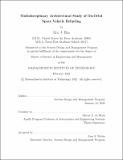Multidisciplinary Architectural Study of On-Orbit Space Vehicle Refueling
Author(s)
Ehn, Eric J.
DownloadThesis PDF (6.775Mb)
Advisor
de Weck, Olivier L.
Terms of use
Metadata
Show full item recordAbstract
The next generation of space exploration is filled with bigger and more enterprising missions, like human exploration of Mars and in-space harvesting of energy. In space servicing, specifically on-orbit refueling offers a chance to achieve these ambitious space mission goals. To understand how on-orbit architectures can produce value for space systems a Technology Roadmapping method is used to analyze the foundations of on-orbit refueling, understand the on-orbit refueling landscape, and consider efficient paths forward to developing on-orbit refueling systems. Using a multidisciplinary architectural analysis of on-orbit refueling systems, this thesis aims to clarify what investments and efforts are crucial to establishing the road to on-orbit refueling.
Existing on-orbit refueling systems have steadily increased the mass of propellant they can refuel from Orbital Express’ 22 kilograms in 2007 to Tianzhou 2’s delivery of 2000 kilograms in 2021, yet refueling rates like the industry-leading Robotic and Refueling Mission’s .155 kilograms per second demonstrated in 2012 shows that some technology areas could still hold back legitimate refueling operations. Refueling system designers should consider a few insights from this research to help define architectures that close existing gaps in refueling system performance.
Missions that have higher delta v budgets (i.e military maneuvering, MEO, and GEO missions) have a larger potential for improvement due to refueling. Using a technical model that analyses refuel time, propellant mass delivered, and space vehicle pmf efficiency, the best MEO and GEO refueling systems produced higher utility scores (.79) than the best LEO systems (.73). The best LEO systems show an estimated total mission cost savings of around $100 million, while MEO and GEO refueling systems offer much higher total mission cost savings of $300 million to $1 billion.
Tank exchange and propellant augmentation refueling methods shine over robotic arm pumping or direct docking and pumping methods, due to bypassing the typically slow micro-gravity pumping rates, lower instrument mass, and less complexity. For comparable high-value LEO systems, tank exchange refueling systems can be built for 12% lower unit costs and produce 27% lower total mission costs than refuelers with pumping mechanisms. Refueling a higher number of customers always adds more value in this research’s modeling, but surprisingly refueling the same system multiple times appears to have a diminishing value return around 4-6 refuels. Partnerships will be essential to correctly define space vehicle standard interfaces for refueling and growing a sufficient customer base to maximize value.
A high-value 2030 roadmap includes targeting MEO and GEO tank exchange re-fueling systems. To achieve that goal, start by defining and building 200 kilogram delivery size LEO refueling prototypes using tank exchange or propellant augmentation methods to prove assumed high-TRL sub-systems, accurately gauge demand, and push forward standardized docking inter-faces. Financial modeling of a LEO tank exchange prototype shows the system could be built for roughly $200 million, improving space mission systems mass efficiency by 50% on day one, providing a potential IRR of 25%, and potentially returning value of after 4 years of refueling service; saving conservatively $103 million for mission system owners. Once the prototypes prove TRL advancements, assert standard refueling interfaces, and industry partnerships support refueling demand, the prototypes can be scaled or positioned in high demand refueling locations.
Date issued
2022-02Department
System Design and Management Program.Publisher
Massachusetts Institute of Technology